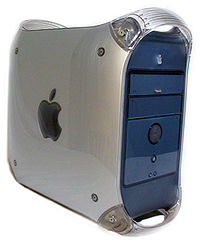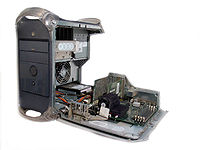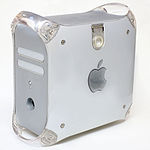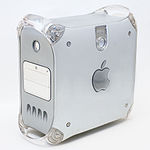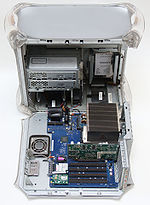- Power Mac G4
-
Power Mac G4 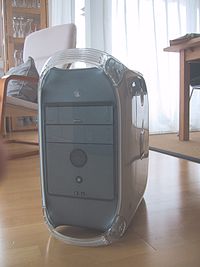
The "Graphite" Power Mac G4Developer Apple Inc. Release date August 31, 1999 Discontinued June 9, 2004 CPU single or dual PowerPC G4,
350 MHz – 1.4 GHz (Up to 2GHz processors through 3rd-party.)The Power Mac G4 was a series of personal computers that was designed, manufactured, and sold by Apple between 1999 and 2004. They used the PowerPC G4 (PPC74xx) series of microprocessors. They were heralded by Apple to be the first personal supercomputers, reaching speeds of 4 to 20 Gigaflops. It was both the last Macintosh to boot natively into Classic Mac OS and the first to boot exclusively into Mac OS X.
Contents
Original models
The original Apple Power Mac G4, code name "Yikes!", was introduced at the Seybold conference in San Francisco on August 31, 1999,[1] with 400 MHz, 450 MHz and 500 MHz configurations available. In October 1999, Apple was forced to postpone the 500 MHz because of poor yield of the 500 MHz chips. In response, Apple “speed dumped” the processor speed in each configuration by 50 MHz but caused some controversy by not decreasing the price of the machines.[2]
The early 400 MHz (later 350 MHz) PCI-based version used a motherboard identical to the one used in Power Macintosh G3 (Blue & White) computers (minus the ADB port), in a "graphite" colored case and with the new Motorola PowerPC 7400 (G4) CPU. The higher-speed models, code name "Sawtooth", used a greatly modified motherboard design with AGP 2x graphics (replacing the 66 MHz PCI slot). In December 1999, the entire Power Mac G4 line was updated to the AGP motherboard.
The machines featured DVD-ROM drives as standard. The 400 MHz and 450 MHz versions had 100 MB Zip drives as standard equipment, and as an option on the 350 MHz Sawtooth. This series had a 100 MHz system bus and four PC100 SDRAM slots for up to 2 GB of RAM (1.5 GB under Mac OS 9). The AGP Power Macs were the first to include an AirPort slot and DVI video port.
The 500 MHz version was reintroduced on February 16, 2000, accompanied by 400 MHz and 450 MHz models. DVD-RAM and Zip drives featured on these later 450 MHz and 500 MHz versions and were an option on the 400 MHz.
Apple's marketing name for all these early AGP models is Power Mac AGP Graphics. The code name Sawtooth was used internally before release and became the popular designation among enthusiasts.
The design was updated at the Macworld Expo New York on July 19, 2000; the new revision included dual-processor 450 MHz and 500 MHz versions, and a low-end single CPU 400 MHz model. It was also the first personal computer to include gigabit Ethernet as standard. Most people saw this revision as a stopgap release, because higher clocked G4s were not available; the G4’s Motorola XPC107 “Grackle” PCI/Memory controller prevented the G4 from hitting speeds higher than 500 MHz.[citation needed] The dual 500 MHz models featured DVD-RAM optical drive. Zip drives were optional on all models. These models also introduced Apple's proprietary Apple Display Connector video port.
Apple's marketing name for this series is the Power Mac Gigabit Ethernet. The code name was Mystic.
Component Power Mac G4 (PCI Graphics) Power Mac G4 (AGP Graphics) Power Mac G4 (Gigabit Ethernet) Codename "Yikes!" "Sawtooth, P5, Project E" "Mystic, Medusa2, SnakeBite" Processor 350 or 400 MHz PowerPC G4 (7400) 350, 400, 450, or 500 MHz PowerPC G4 (7400) 400, Dual 450, or Dual 500 MHz PowerPC G4 (7400) Cache 64 KB L1, 512 KB or 1 MB backside L2 Cache per CPU (1:2) Graphics Card ATI Rage 128 with 16MB of VRAM
66 MHz PCI SlotATI Rage 128 or ATI Rage 128 Pro with 16MB of VRAM
AGP 2xATI Rage 128 Pro with 16MB VRAM or ATI Radeon with 32MB of VRAM
AGP 2x. ADC Monitor supportFront side bus 100 MHz Memory 64, 128, or 256 MB PC100 SDRAM
Expandable to 1 GB64, 128, or 256 MB PC100 SDRAM
Expandable to 2 GB under Mac OS X. Only 1.5 GB is seen under Mac OS 9Hard drive 10 GB
Up to 128 GB10 GB 5400-rpm, 10, 20, or 27 GB 7200-rpm
Up to 128 GB (10.4.11 and newer support more 128 Gb with special software)20 GB 5400-rpm, 30, or 40 GB 7200-rpm
Up to 128 GB (10.4.11 and newer support more 128 Gb with special software)AirPort Card N/A 802.11b Optical drive CD-ROM 32x CD-ROM, DVD-ROM, or DVD-RAM DVD-ROM or DVD-RAM Expansion 4 internal 3.5" ATA drive bays, 1 optical drive bay, 1 Zip 100 bay, 3 - 33 MHz and 1 - 66 MHz PCI Slots 4 internal 3.5" ATA drive bays, 1 optical drive bay, 1 Zip 100/250 bay, 3 - 64-bit 33 MHz PCI Slots, 1 AGP 2x Slot Standard Features 2 Built-in USB 1.1 and 2 Firewire 400 ports, Built-in mono speaker, audio input, audio output, 10/100BASE-T Ethernet, Built-in modem 2 Built-in USB 1.1 and 3 Firewire 400 ports (1 internal), Built-in mono speaker, Audio Input, Audio Output, Built-in modem, 10/100BASE-T Ethernet, Optional Airport Card 2 Built-in USB 1.1 and 2 Firewire 400 ports, Built-in mono speaker, audio input, audio output, Built-in modem, 10/100/1000BASE-T Gigabit Ethernet, Optional Airport Card Maximum Operating System Mac OS X 10.4.11 "Tiger" and Mac OS 9.2.2 Mac OS X 10.4.11 "Tiger" and Mac OS 9.2.2
Unofficially can support Mac OS X v10.5 "Leopard" with LeopardAssistWeight 13 kgs (28.7 pounds) 13.6 kgs (30 pounds) Four-slot models
A new line with a revamped motherboard but the familiar "Graphite" case debuted on January 9, 2001. It was essentially a future Quicksilver inside an older case. Motorola had added a seventh pipeline stage in the new PowerPC G4 design to achieve faster clock frequencies. New features included a fourth PCI slot, a 133 MHz system bus, an improved 4X AGP slot, and a new "digital audio" sound system, giving the series its name "Power Mac Digital Audio". The models were offered in 466 MHz, 533 MHz, dual 533 MHz, 667 MHz and 733 MHz configurations, the latter two using a newer PowerPC 7450 processor. The number of RAM slots were reduced to three, accommodating up to 1.5 GiB of PC133 SDRAM.
The 733 MHz model was the first personal computer to include a built-in DVD-R or Apple-branded SuperDrive, the rest of the line became the first Macs to ship with CD-RW drives. This was also the first series of Macs to include an nVidia graphics card, the venerable GeForce 2MX.
At Macworld Expo New York on July 18, 2001, a new line debuted featuring a cosmetically redesigned case known as "Quicksilver", but only minor technical changes. It was available in 733 MHz, 867 MHz and dual 800 MHz configurations. The 733 MHz model was notable for not having a level three cache.
The design was updated on January 28, 2002 with 800 MHz, 933 MHz and dual 1 GHz configurations, becoming the first Mac to reach 1 GHz. Again, the low end 800 MHz model did not include any level three cache. The graphics in this series were provided by an nVidia GeForce4 MX card. Some of these models have ATA controllers with 48 bit LBA for hard drives larger than 128 GB. This later series is commonly known as Quicksilver 2002.
Component Power Mac G4 (Digital Audio) Power Mac G4 (QuickSilver) Power Mac G4 (QuickSilver 2002) Power Mac G4 (QuickSilver 2002ED) Codename "Tangent, Clockwork" "Titan, Nichrome" N/A N/A Processor 466, 533, Dual 533, 667, or 733 MHz PowerPC G4 (7400/7410/7450) 733, 867, or Dual 800 MHz PowerPC G4 (7450) 733 (education only), 800, 933 MHz, or Dual 1.0 GHz PowerPC G4 (7450/7455) 867 MHz PowerPC G4 (7455) Cache 64 KB L1, 256 KB (1:1) or 1 MB (1:2) L2, 1 MB L3 (733 MHz) 64 KB L1, 256 KB (1:1) L2, 2 MB L3 (867/Dual 800 MHz) 64 KB L1, 256 Kb (1:1) L2, 2 MB DDR L3 (933/Dual 1.0 GHz) 64 KB L1, 256 Kb (1:1) L2 Graphics ATI Rage 128 Pro with 16 MB VRAM, ATI Radeon or nVidia GeForce2 MX with 32 MB VRAM, GeForce3 with 64 MB VRAM nVidia GeForce2 MX with 32 MB VRAM, Geforce2 MX with TwinView or Geforce3 with 64 MB VRAM ATI Radeon 7500 with 32 Mb VRAM, nVidia GeForce4 MX with 64 MB VRAM or GeForce4 Ti with 128 MB VRAM nVidia GeForce4 MX with 32 MB VRAM Front side bus 133 MHz Memory 128, 256, or 512 MB of PC133 SDRAM
Expandable to 1.5 GBHard drive 30GB 5400-rpm, 40GB or 60GB 7200-rpm
Up to 128 GB40GB 5400-rpm, 60GB or 80GB 7200-rpm
Up to 128 GB40GB, 60GB or 80GB 7200-rpm
Supports Hard Drives larger than 128GB40GB 7200-rpm
Supports Hard Drives larger than 128GBAirPort 802.11b Card Optical drive DVD-ROM, 8x4x32x CD-RW, or 2x/6x/8x/4x/24x DVD-R/CD-RW SuperDrive. Optional Zip 250 drive 12x10x32x CD-RW, or 8x/8x/8x/32x DVD/CD-RW, or 2x/4x/8x/4x/24x SuperDrive 24x10x32x CD-RW, or 8x/12x/8x/32x DVD/CD-RW, or 2x/6x/8x/4x/24x DVD/CD-RW (2x SuperDrive) 24x10x32x CD-RW Expansion 4 - internal 3.5" ATA drive bays, 1 - optical drive bay, 1 - Zip 250 bay, 4 - 64-bit 33 MHz PCI Slots, 1 - 4x AGP Slot Standard Features 2 Built-in USB 1.1 and 2 Firewire 400 ports, Built-in mono speaker, audio in, audio out, Apple Pro Speaker minijack, 10/100/1000BASE-T Gigabit Ethernet, Built-in modem Maximum Operating System Mac OS X 10.4.11 “Tiger” and Mac OS 9.2.2
Unofficially, these models can run Mac OS X 10.5 “Leopard”Mac OS X 10.4.11 “Tiger” and Mac OS 9.2.2 on 733 and Dual 800 MHz. Mac OS X 10.5 “Leopard” on 867 MHz
Unofficially, 733 and Dual 800 MHz models can run Mac OS X 10.5 “Leopard”Mac OS X 10.4 “Tiger” and Mac OS 9.2.2 on 733 and 800 MHz. Mac OS X 10.5 “Leopard” on 933 MHz and Dual 1.0 GHz
Unofficially, 733 and 800 MHz models can run Mac OS X 10.5 “Leopard”Mac OS X 10.5 “Leopard” Weight 13.6 kgs (30 Pounds) DDR models
Another generation of Apple Power Mac G4s were introduced on August 13, 2002, featuring both a new Xserve-derived DDR motherboard architecture and a new case design, known as "Mirrored Drive Doors" (MDD). All models were available in dual processor configurations running at 867 MHz, 1 GHz or 1.25 GHz. As with the Xserves, the PowerPC 7455 CPU used does not have a DDR frontside bus, meaning the CPU could only use at most 50% of the new system's theoretical memory bandwidth, providing no improvement over previous models. The rest was available to the graphics card and I/O systems. A dual processor 1.25 GHz model would be the last Power Mac G4 the company offered to the public after the announcement of the new Power Mac G5, introduced in June 2003.
A limited range of serial numbers of this model was noted for a noisy fan, earning them the unofficial designation "Windtunnel G4" in some circles. Noise complaints became such a problem that Apple later replaced the machine's power supply (PSU) and primary cooling fan with quieter versions, and initiated a voluntary do-it-yourself (DIY) replacement scheme for all previously sold machines. A very common issue in the MDD models was a failing PSU. At least some MDD models also have a design flaw resulting in noise in the audio-out, picking up interference from the mouse, graphics card, hard drive and other hardware. According to Apple, this is a ground loop issue, and only occurs when used with professional balanced signal audio equipment,[3] however some audio experts have contended it is due to shielding defects on the motherboard and affects all equipment.[4]
The last real update to the Power Mac G4 line was on January 28, 2003 offering dual 1.42 GHz PowerPC 7455 processors, with features not seen in previous DDR models: built-in FireWire 800 connector, optional integrated Bluetooth, and optional integrated AirPort Extreme. These were also the first Power Macs that could not boot into Mac OS 9.
With the launch of the Power Mac G5 on June 23, 2003, Apple quietly re-introduced the August 2002 Power Mac G4 because of perceived demand for Mac OS 9 machines. Between that, its low price-tag, and the delayed availability of Power Mac G5s, it proved a strong seller for a relatively short time. Production stopped on June 9, 2004 and the remaining inventory was liquidated.
Component Power Mac G4 (Mirrored Drive Doors) Power Mac G4 (FW 800) Power Mac G4 (Mirrored Drive Doors 2003) Codename "P57" "P58" N/A Model Number M8570 M8570 M9145, M9309 Processor Dual 867 MHz, Dual 1.0, or Dual 1.25 GHz PowerPC G4 (7455) 1.0, Dual 1.25, or Dual 1.42 GHz PowerPC G4 (7455) 1.25 GHz PowerPC G4 (7455/7455B) Cache 64 KB L1, 256 KB L2, 1 MB or 2 MB DDR L3 Graphics Card nVidia GeForce4 MX with 32 MB VRAM, ATI Radeon 9000 Pro with 64 MB VRAM, or GeForce4 Ti with 128 MB VRAM nVidia GeForce4 MX or ATI Radeon 9000 Pro with 64 Mb VRAM, GeForce4 Ti or Radeon 9700 Pro with 128 MB VRAM ATI Radeon 9000 Pro with 64 MB VRAM or nVidia GeForce4 Ti 128 MB Front side bus 133 MHz (Dual 867 MHz) or 167 MHz (Dual 1.0 GHz+) 133 MHz (1.0 GHz) or 167 MHz (Dual 1.25 GHz+) 167 MHz Memory 256, 512 MB PC-2100 (dual 867), or PC-2700 (dual 1+) DDR SDRAM
Expandable to 2 GB256, 512 MB PC-2100 (1.0 GHz), or PC-2700 (dual 1.25+) DDR SDRAM
Expandable to 2 GB256, 512 MB PC-2700 DDR SDRAM
Expandable to 2 GBHard drive 60, 80, or 120 GB 7200-rpm
Supports Hard Drives larger than 128 GB80 or 160 GB 7200-rpm AirPort Card 802.11b AirPort Extreme 802.11b/g 802.11b Bluetooth N/A Bluetooth 1.1 N/A Optical drive 8x/16x/10x/32x DVD/CD-RW or 2x/6x/8x/4x/24x DVD-R/CD-RW (2x SuperDrive) 12x/32x/10x/32x DVD/CD-RW or 4x/8x/16x/8x/32x DVD-R/CD-RW (4x SuperDrive) 12x/32x/10x/32x DVD/CD-RW Expansion 4 - internal 3.5" ATA drive bays (2 - ATA/100, 2 - ATA/66), 2 - optical drive bays, 4 - 64-bit 33 MHz PCI Slots, 1 - 4x AGP Slot Standard Features 2 Built-in USB 1.1 and 2 Firewire 400 ports, Built-in mono speaker, Audio input, Audio output, Apple Pro Speakers minijack, 10/100/1000BASE-T Gigabit Ethernet, Built-in modem, Optional Airport Card 2 Built-in USB 1.1, 2 Firewire 400 ports, 1 Firewire 800 port, Built-in mono speaker, Audio Input, Audio Output, Apple Pro Speakers minijack, 10/100/1000BASE-T Gigabit Ethernet, Built-modem, Optional Airport Extreme Card, Optional Bluetooth 2 Built-in USB 1.1 and 2 Firewire 400 ports, Built-in mono speaker, Audio input, Audio output, Apple Pro Speakers minijack, 10/100/1000BASE-T Gigabit Ethernet, Built-in modem, Optional Airport Card Maximum Operating System Mac OS X 10.4.11 "Tiger" and Mac OS 9.2.2
Mac OS X v10.5 "Leopard"Mac OS X v10.5 "Leopard"
No Mac OS 9 supportMac OS X 10.4.11 "Tiger" and Mac OS 9.2.2
Mac OS X v10.5 "Leopard"Weight 19.1 kgs (42 Pounds) See also
Notes
- ^ "Apple Unveils Power Mac G4". Apple Inc.. 1999-08-31. http://www.apple.com/ca/press/1999/08/Seybold.html. Retrieved 2008-06-30.
- ^ "The 400 MHz PowerMac Reviewed". The Mac Observer. 2000-02-21. http://www.macobserver.com/newreviews/bc/00/000221powermacg400/powermacg4400.html. Retrieved 2008-10-19.
- ^ [1] apple.com
- ^ [2] www.sweetwater.com
Apple Model Navigation Replaced Current Model Successor Power Mac G4
Preceding Family Model August 31, 1999 Following Family Model Apple hardware since 1998 Consumer computers Professional computers Notebook computers Consumer electronics Apple TV · Displays (Thunderbolt, Cinema, Studio) · iPad (Original, 2) · iPhone (Original, 3G, 3GS, 4, 4S) · iPod (Classic: 1G, 2G, 3G, 4G, Photo, 5G, 6G; Mini: 1G, 2G; iPod+HP; Shuffle: 1G, 2G, 3G, 4G; Nano: 1G, 2G, 3G, 4G, 5G, 6G; Touch: 1G, 2G, 3G, 4G) · Newton (MessagePad: 2000, 2100; eMate 300)Accessories AirPort (Card: B, G, N; Base Station: Graphite, Snow, Extreme G, N, Express G, N) · iPod (Click Wheel, Dock Connector, Camera Connector, iPod Hi-Fi, Nike+iPod) · iSight · Keyboard (Pro, Wireless) · Magic Trackpad · Mouse (USB, Pro, Wireless, Mighty, Magic) · Remote · SuperDrive · Time Capsule · USB Modem · Xserve RAIDApple hardware Mac Desktop CurrentDiscontinuedMobile CurrentDiscontinuedServer DiscontinuedDevices CurrentDiscontinuedInteractive TV Box · iPhone: (Original, 3G) · iPod Hi-Fi, mini · Newton · Pippin · PowerCD · QuickTakeAccessories CurrentAirPort · Displays · iSight · Magic Mouse · Magic Trackpad · Remote · SuperDrive · Time Capsule · Wireless Keyboard · KeyboardsDiscontinuedCurrent products are bolded; see a list of discontinued products. See also a timeline and previous templates (all; before 1998; since 1998).Categories:- Macintosh towers
- Power Macintosh
- PowerPC Macintosh computers
Wikimedia Foundation. 2010.

